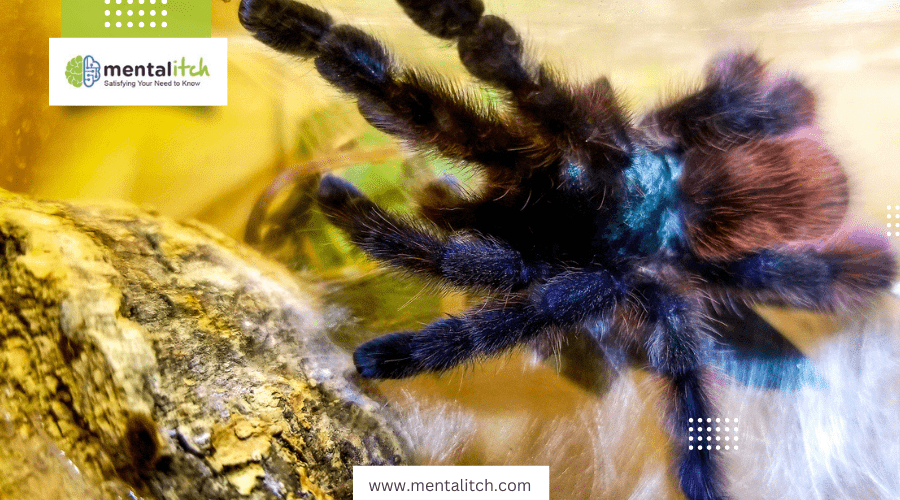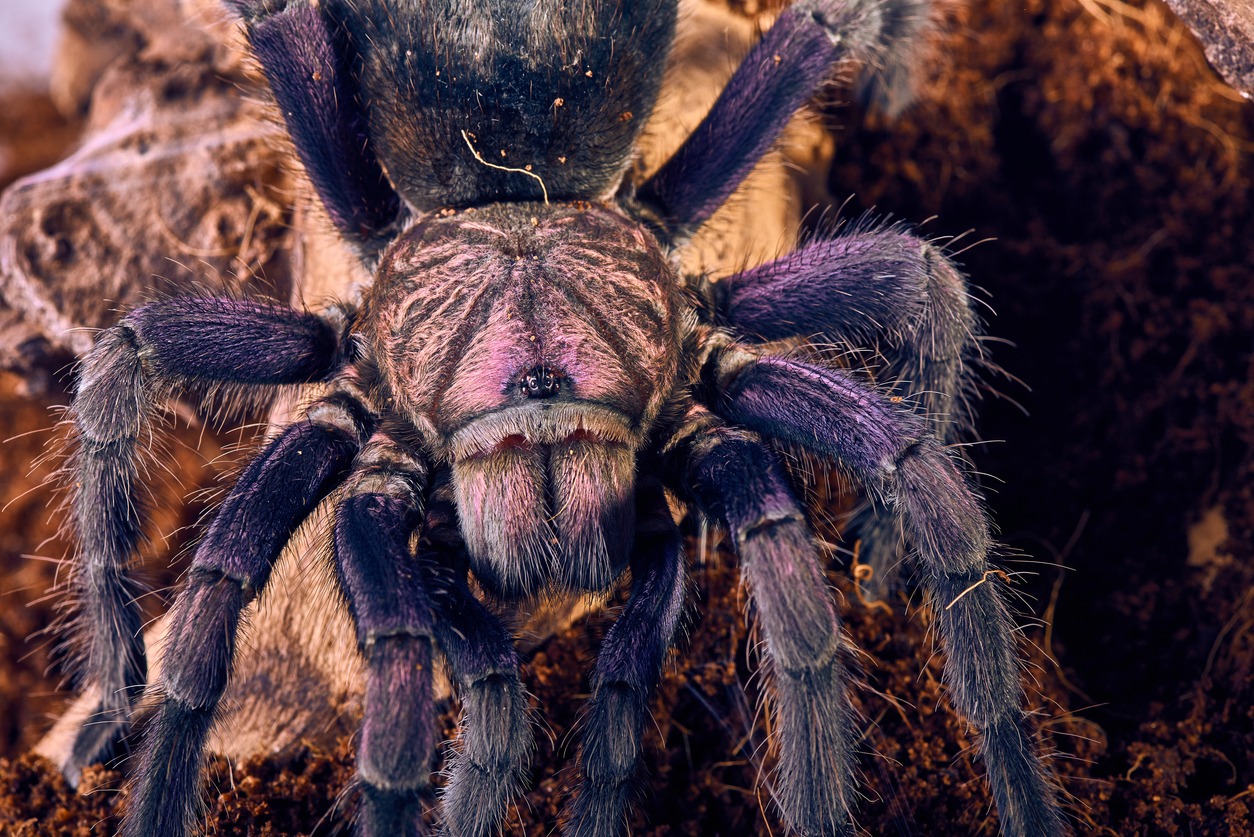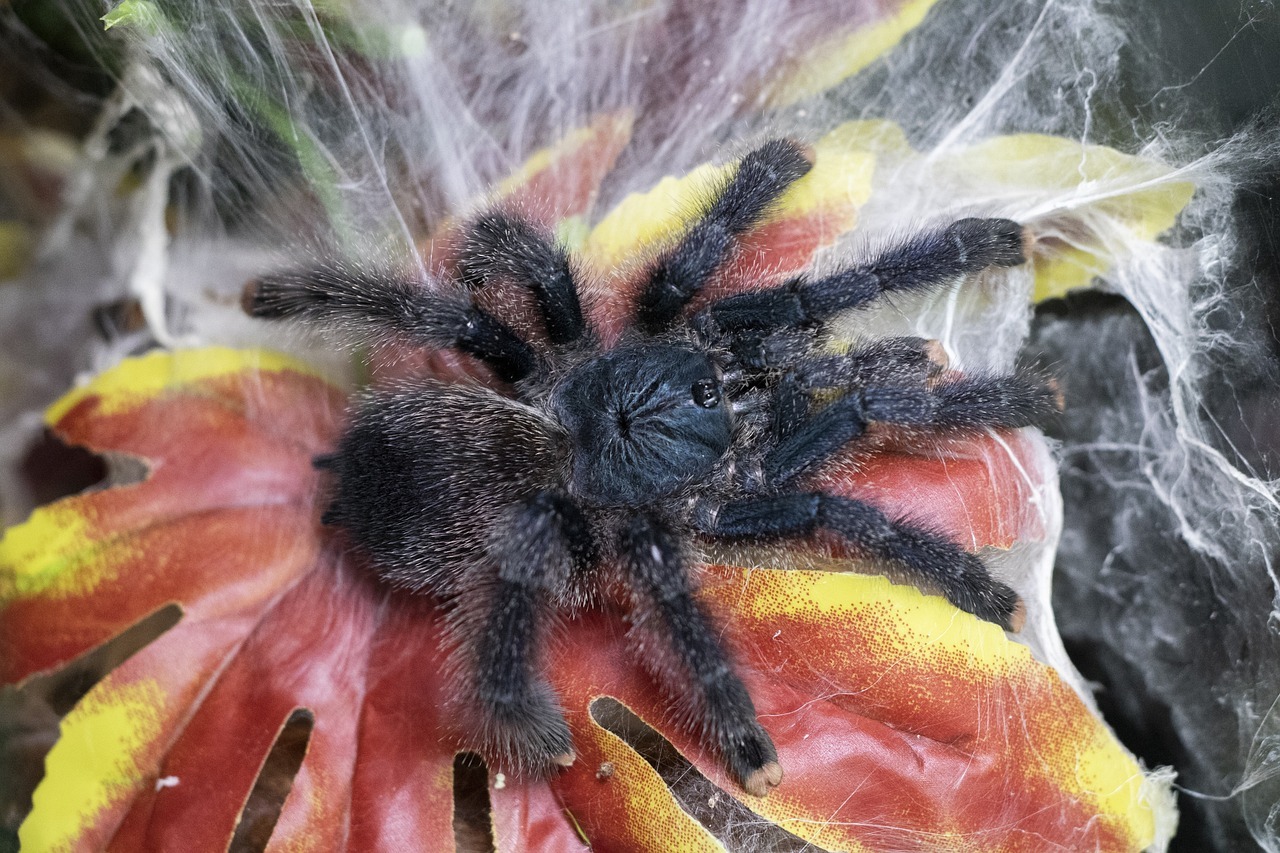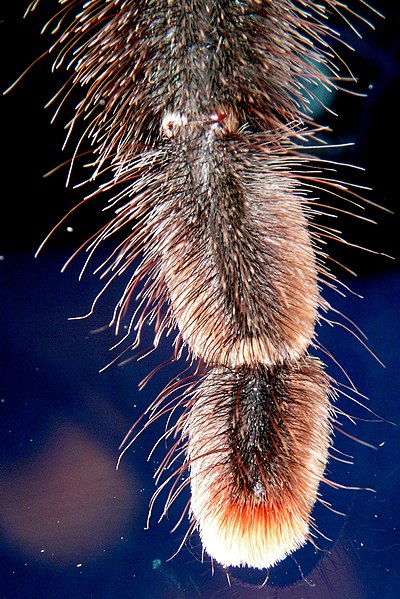Imagine you’re trekking through the lush canopy of a South American rainforest and you spot a Pink Toe Tarantula nestled in a tree. This sight alone sets it apart from its ground-dwelling cousins, highlighting its unique arboreal lifestyle. As you observe its striking pink-tipped legs, you begin to wonder what other secrets this intriguing species holds. From its distinctive hunting methods to its surprisingly social behavior, the Pink Toe Tarantula defies many tarantula stereotypes.
To fully appreciate the nuances of its existence, one must explore further into its world, where each discovery peels back another layer of its complex nature.
Unique Physical Appearance
Although many tarantulas blend into their surroundings, Pink Toe Tarantulas stand out due to their distinctive pink-tipped legs and iridescent black bodies. This unique physical appearance isn’t just for show; it sets them apart in the vast world of tarantulas. Their vibrant pink toes, coupled with the shimmering green iridescence on their black bodies, make them a visually striking species. You’ll find that these features are key identifiers, making Pink Toe Tarantulas easily distinguishable from their counterparts in the wild.
Thus, the sexual dimorphism displayed by these creatures adds another layer to their uniqueness. Females, being larger and more colorful than males, showcase the diversity within the species. This difference isn’t just a minor detail; it’s a significant aspect of their biology that fascinates enthusiasts and experts alike.
While their size might be smaller compared to giants like the Goliath Bird-Eating Tarantula, don’t let that fool you. Their standout coloration and size variation contribute to the allure that Pink Toe Tarantulas hold. It’s these distinctive traits that not only differentiate them from other species but also make them a favorite among tarantula enthusiasts.
Arboreal Lifestyle
Adapting to life high among the branches, Pink Toe Tarantulas exhibit remarkable climbing abilities and behaviors suited to an arboreal lifestyle. As an arboreal species, they spend their days nestled in trees and plants, mastering the art of vertical living. Their bodies are equipped with unique climbing adaptations, allowing them to navigate their leafy world with ease. Unlike their ground-dwelling counterparts, Pink Toes are agile climbers, using their strong limbs and specialized silk to construct secure nests high off the ground.
Their preference for tree life strongly influences their hunting techniques. Relying on ambush tactics, they wait in elevated positions to pounce on unsuspecting prey passing below. It’s a thrilling sight, showcasing their mastery of the vertical world. When you’re setting up their home in captivity, remember, they need more than just horizontal space. They thrive in enclosures that mimic their natural treetop habitats, complete with ample vertical space for climbing. This need for height is a sign of their unique lifestyle, one that sets them apart from their terrestrial relatives. So, if you’re caring for one, always make sure they’ve got room to climb. It’s not just a preference; it’s in their nature.
Social Behavior Differences
After exploring their arboreal lifestyle, it’s important to understand that pink toe tarantulas also stand out due to their solitary social behavior, preferring solitude over the company of others. Unlike some tarantula species that might enjoy the occasional company, pink toes find solace in their own space. They’re not the type to gather or live communally. In fact, their interactions with other tarantulas are minimal, mainly occurring during mating periods.
You’d find it fascinating that, despite their solitary nature, pink toes aren’t as aggressive towards their own kind as you might expect. They coexist without the threat of cannibalism looming overhead, even in closer quarters. However, don’t let this fool you into thinking they’re social butterflies. Post-mating, females might show aggressive tendencies towards males, a stark reminder of their preference for solitude.
Unlike their communal cousins, pink toe tarantulas don’t share webs or engage in cooperative hunting. They’re the epitome of independence in the spider world, making their solitary lifestyle a distinguishing trait. So, if you’re pondering the differences between pink toes and other tarantulas, their preference for living alone is a significant one.
Distinctive Diet Habits
Pink toe tarantulas showcase a carnivorous diet, primarily feasting on insects like crickets and grasshoppers, setting them apart in their dietary habits. Unlike some of their tarantula cousins who might stick closely to a specific type of prey, these creatures expand their menu. They don’t stop at just munching on insects; they also hunt small tree frogs and lizards. This shows their adaptability and diverse diet habits, making them quite the hunters of the arachnid world.
What’s fascinating is how pink toe tarantulas hunt. They don’t just chase down their prey; they use silk traps, demonstrating a strategic approach to capturing their next meal. It’s not just about speed or strength; it’s about cunning and patience, which sets their hunting methods apart.
Even though they’re hunters, their venom isn’t a big threat to us humans, making them relatively safe to handle. But don’t think they’re defenseless. When threatened, they can leap short distances to evade danger, showing they’re not just about offense in their diet habits. Their distinctive approach to hunting and their diet habits highlight how unique pink toe tarantulas are in the spider world.
Reproduction and Lifecycle
Understanding the reproduction and lifecycle of pink toe tarantulas is key to appreciating how these creatures thrive in their natural habitat and captivity. When it comes to reproduction, these tarantulas breed annually, an event that can last anywhere from a few minutes to several hours, depending on various factors. After mating, female pink toe tarantulas lay their eggs, which gestate for about 7 weeks before the spiderlings hatch. This period is important for the continuation of their species, both in the wild and for those breeding them in captivity.
The lifespan of pink toe tarantulas also plays a significant role in their lifecycle. Females can live between 6 to 9 years, a relatively long life that allows them to breed multiple times. Males, however, have a shorter lifespan, living only 2 to 3 years. This difference means that females have more opportunities for reproduction, which can impact the population dynamics of these fascinating creatures.
Furthermore, the success of mating often hinges on the female’s condition. Well-fed females are more receptive to mating, which underscores the importance of nutrition in their reproductive success. Understanding these aspects of pink toe tarantula reproduction and lifespan sheds light on their survival strategies and the efforts needed to sustain their populations in captivity.
Predators and Threat Management
In their battle for survival, pink toe tarantulas have developed effective defenses against predators, including venom and urticating hairs. Their ability to navigate the dangers of the wild is a confirmation to their resilience and adaptability. As they hunt under the cover of night, they also safeguard themselves from becoming prey. Their agility and speed are important in their arboreal habitat, allowing them to escape when danger looms.
These spiders employ a variety of defense mechanisms to guarantee their survival:
- Venom and Urticating Hairs: These are their first line of defense against attackers. The venom incapacitates smaller threats, while the urticating hairs deter larger predators.
- Agility and Speed: In the treetops, their swift movements and ability to leap short distances are essential for avoiding harm.
- Nocturnal Hunting: By being active at night, they avoid many diurnal predators, reducing the risk of encounters.
- Defensive Postures and Warning Signals: Before resorting to venom or fleeing, they may display intimidating postures or signals to ward off potential threats.
Understanding these defense mechanisms highlights the pink toe tarantula’s remarkable ability to manage threats in their environment, ensuring their continued survival in the wild.
Color Variation Significance
The vibrant colors of adult male pink toe tarantulas, ranging from blue to purple, aren’t just for show; they play a significant role in camouflage and mating. These color variations are essential adaptations that allow these spiders to thrive in their natural habitats. While juvenile pink toes start their lives mainly blue, they undergo remarkable changes as they mature. This transformation is not only a marvel of nature but also a demonstration to the tarantula’s ability to adapt.
| Age Group | Color | Purpose |
|---|---|---|
| Juvenile | Blue | Initial camouflage |
| Adult Male | Blue, Green, Red, Orange, Purple, Pink | Camouflage & attracting mates |
| Adult Female | Less colorful | Camouflage |
Adult females, being generally less colorful, still blend seamlessly into their surroundings, hinting at the evolutionary advantage of subtlety in certain contexts. Understanding these color variations offers insights into the pink toe tarantula’s behavior and strategies for survival and reproduction. It’s a clear example of how adaptation through color variation isn’t just about aesthetics; it’s a critical component for success in the wild.
Hunting Techniques
Pink toe tarantulas employ silk traps as their primary hunting method, catching prey like insects and small vertebrates with remarkable efficiency. Unlike some tarantulas that might wait passively in their burrows, these agile hunters take a more active approach. They’re nocturnal, which means they hunt under the cover of darkness, utilizing their agility and the element of surprise to their advantage. Their ability to leap short distances sets them apart from others, making them fascinating subjects of study.
Here’s what makes their hunting techniques unique:
- Silk Traps Over Strength: They rely more on their silk traps than brute strength to catch prey, showcasing their engineering skills.
- Nocturnal Agility: They use the night to their advantage, moving with stealth and precision to outmaneuver their prey in the dark.
- Ambush Tactics: Patient yet opportunistic, they wait for the perfect moment to strike, embodying the essence of ambush predators.
- Leap and Pounce: Their ability to leap adds an extra dimension to their hunting strategy, allowing them to quickly close in on or escape from threats.
Understanding these tactics not only highlights their adaptability but also underscores the diversity of survival strategies among tarantulas.
Habitat Preferences
Arboreal habitats, specifically lush tropical rainforests, are where you’ll find pink toe tarantulas thriving, far from the ground-dwelling counterparts in their species. Unlike their desert-dwelling kin, these creatures relish the humidity and dense vegetation that rainforests offer, making them unique among tarantulas. If you’re fascinated by these spiders, you must understand their distinct preferences for living high up in the trees and plants of northern South America’s rainforests.
Here’s a quick look at how pink toe tarantulas’ habitat preferences compare to other tarantulas:
| Feature | Pink Toe Tarantulas | Other Tarantulas |
|---|---|---|
| Habitat | Arboreal in rainforests | Mostly terrestrial |
| Location | Northern South America | Various, including deserts |
| Environment | Humid, lush | Diverse, often less humid |
| Ventilation Needs | Requires cross ventilation | Less specific needs |
Living an arboreal lifestyle, pink toe tarantulas spend their time climbing and hiding in the foliage, showcasing their agility and preference for the vertical life. Their need for cross ventilation in captivity mimics the airflow of their natural rainforest environment, emphasizing the importance of recreating their unique habitat for their well-being.
Conservation Status Insights
Understanding the conservation status of Pink Toe Tarantulas gives us insight into their vulnerability and the need for future protection measures. Despite being a favorite among pet enthusiasts, their current status as ‘Not Evaluated’ by the IUCN shows a gap in our understanding of their well-being in the wild. Here’s what this means for you and the Pink Toe Tarantula:
- Lack of Thorough Assessment: The ‘Not Evaluated’ status highlights that we’re in the dark about the true impact of threats, such as the pet trade, on their populations.
- No Immediate Threats… Yet: While they don’t face immediate threats, the lack of data means we can’t be complacent about their future.
- Millions in the Wild: Estimates suggest millions exist in the wild, a comforting number that also underscores the importance of maintaining their habitat.
- Unregulated Conservation Status: With no international protections, it’s up to us to advocate for assessments and regulations to thus these tarantulas aren’t pushed toward endangerment.
Conclusion
To sum up, you’ve discovered that Pink Toe Tarantulas stand out from their counterparts with their distinct pink-tipped legs, tree-dwelling habits, and unique social behaviors. Their diet, reproduction cycle, and the significance of their color variations further distinguish them. Unlike many tarantulas, they employ specific hunting techniques and prefer certain habitats, contributing to their unique place in the arachnid world. Understanding their conservation status is vital as it highlights the importance of preserving their natural environments for future generations.



